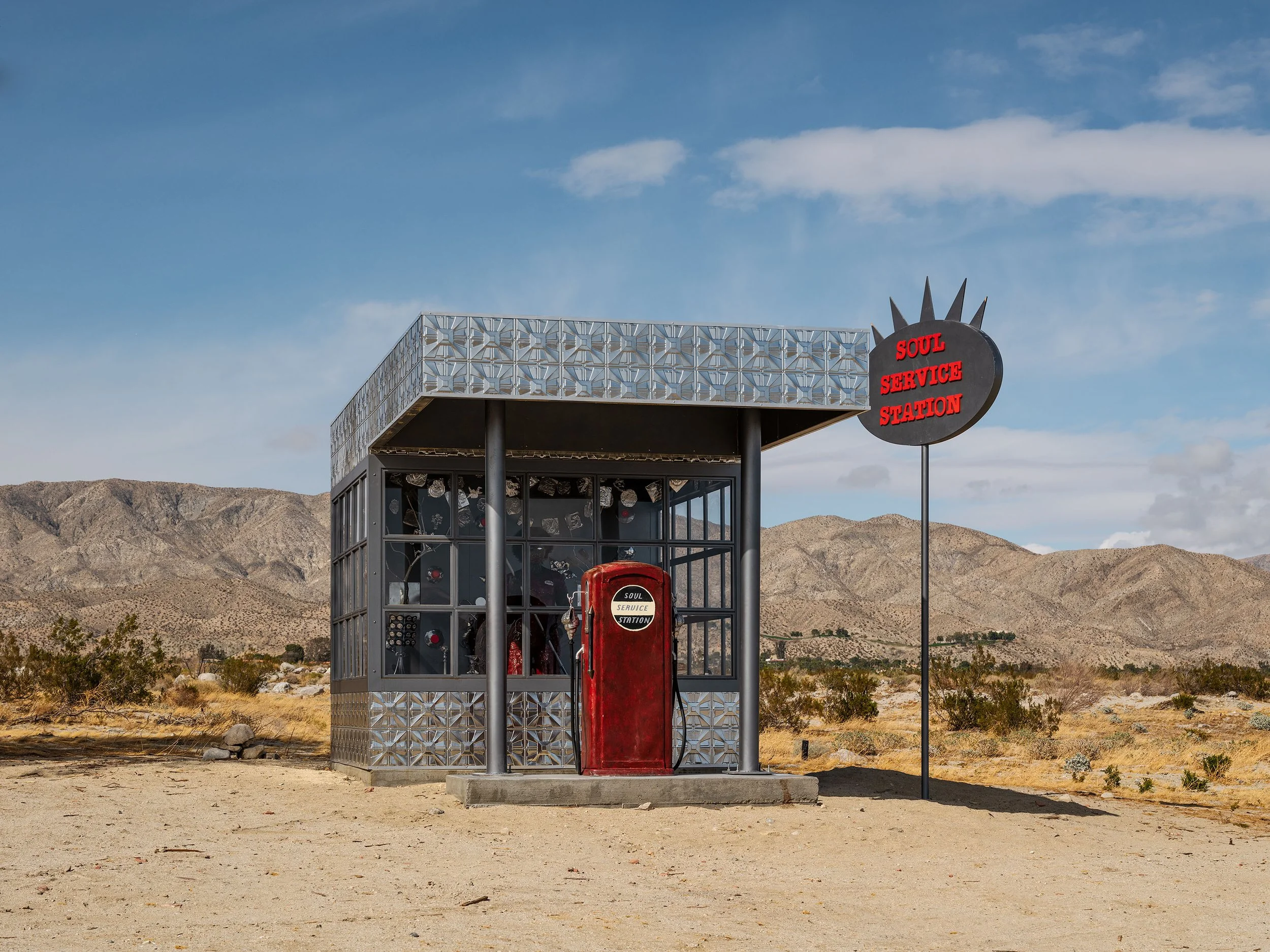ROOM + WILD NATURALS: DESERT X
Held across the Coachella Valley in Southern California, Desert X is a biennial exhibition that brings large-scale, site-specific installations to the desert. Since launching in 2017, it has redefined what contemporary art can look like in open landscapes, placing it directly in dialogue with geology, climate, and the forces of human change. Rooted in the tradition of land art, a movement from the 1960s and 70s where artists used the earth itself as medium, Desert X continues this legacy but with a more urgent and inclusive lens. Today’s desert is not untouched wilderness. It’s a living, shifting place shaped by both ancient forces and modern pressures.
This year’s edition is grounded in time, deep time. The kind shaped by tectonics, erosion, and extinction. But also the kind that shows up in droughts, heat waves, and the rapid sprawl of urban development. The desert is no blank canvas. It holds stories of displacement, adaptation, survival. In Coachella Valley, finding a pure view of the land is increasingly rare. Housing developments, golf courses, and infrastructure press up against every horizon. The artists of Desert X 2025 respond directly to this tension.
“From living sculptures and light-based installations to 3D-printed adobe architecture and Indigenous futurism, Desert X redefines land art by confronting the environmental and cultural complexities of the modern desert landscape.”
Desert X 2025 installation view of Kimsooja, To Breathe – Coachella Valley, photo by Lance Gerber, courtesy Desert X.
Each of the eleven installations in Desert X 2025 offers a way of seeing the desert not just as a setting, but as an active voice in the conversation. The land isn’t just holding the work—it’s part of the work.
Desert X 2025 installation view of Agnes Denes, The Living Pyramid at Sunnylands Center & Gardens, photo by Lance Gerber, courtesy Desert X.
Desert X 2025 installation view of Agnes Denes, The Living Pyramid at Sunnylands Center & Gardens, photo by Lance Gerber, courtesy Desert X.
Agnes Denes returns to her legacy of ecological art with The Living Pyramid, a stepped, sculptural form planted with native desert species. It’s a structure shaped by time and care. As the plants grow, shift, and die back, the piece changes with the seasons—reminding us that nurturing the land is a slow, ongoing act.
Jose Dávila’s work places massive stone blocks throughout the valley, each one shifted slightly out of place. These monolithic forms hint at geological time—what moves slowly, what stays, what breaks away.
Desert X 2025 installation view of Jose Dávila, The act of being together, photo by Lance Gerber, courtesy Desert X.
Raphael Hefti bends perception using light. His installation builds an artificial horizon that shimmers like a mirage—challenging the way we see and suggesting that the line between real and imagined is more fluid than it seems. Meanwhile, Cannupa Hanska Luger constructs a time-traveling caravan—a vision of Indigenous futurism shaped by story, survival, and transformation. It’s a mobile monument to history and possibility.
“Time, light, and space permeate every aspect of this exhibition, coupled with an urgency to imagine new, sustainable ways of living in an increasingly imperiled world. In witnessing the desert’s wisdom, these artists invite us to carry forward its enduring resilience.”
Desert X 2025 installation view of Raphael Hefti, Five things you can’t wear on TV, photo by Lance Gerber, courtesy Desert X.
Desert X 2025 installation view of Cannupa Hanska Luger, G.H.O.S.T. Ride (Generative Habitation Operating System Technology), photo by Lance Gerber, courtesy Desert X.
Architecture plays a central role in several works, highlighting how we build—and what we take from the land to do it. Ronald Rael’s Adobe Oasis uses an adapted 3D-printing robot to create a fully sustainable shelter made of local earth. It blends ancient methods with modern technology, and it’s designed to erode over time, returning to the ground it came from.
Desert X 2025 installation view of Ronald Rael, Adobe Oasis, photo by Lance Gerber, courtesy Desert X.
Alison Saar reimagines a roadside gas station into a place of soul replenishment. Her Soul Service Station isn’t about fuel—it’s about something deeper. A pause. A recharge of spirit.
Desert X 2025 installation view of Alison Saar, Soul Service Station, photo by Lance Gerber, courtesy Desert X.
Desert X 2025 installation view of Muhannad Shono, What Remains, photo by Lance Gerber, courtesy Desert X.
Desert X 2025 installation view of Sanford Biggers, Unsui (Mirror), photo by Lance Gerber, courtesy Desert X, the artist and Marianne Boesky Gallery, New York and Aspen.
Other artists look to the elements. Kimsooja creates a spiral pavilion wrapped in diffraction film that catches the sun, casting rainbows across the desert floor. As the light changes, the structure comes alive—inviting people to move through color and reflection.
Sarah Meyohas uses mirrors and water-like surfaces to cast moving text across the sand, playing with how light holds meaning. Sanford Biggers suspends soft, cloud-like forms above the landscape—symbols of rain and renewal in a place where water is both scarcity and dream.
Desert X 2025 installation view of Kimsooja, To Breathe – Coachella Valley, photo by Lance Gerber, courtesy Desert X.
Desert X 2025 installation view of Kimsooja, To Breathe – Coachella Valley, photo by Lance Gerber, courtesy Desert X.
Desert X 2025 installation view of Kimsooja, To Breathe – Coachella Valley, photo by Lance Gerber, courtesy Desert X.
Muhannad Shono’s installation draws from the wind itself. Using fabric laced with sand, he captures the subtle shifts and undulations of the desert’s breath. It’s a quiet reminder that in this place, movement is constant—even if you can’t always see it.
Each artist asks us to slow down and pay attention. To listen to the rhythms of this land, to see what’s been buried or overlooked, and to consider what kind of future can take root here.
“As the landscape evolves and adapts, so do the artists and their responses. Fifty years ago, land art consisted largely of white men using the vast expanse of wilderness as a gestural canvas. Today, Desert X reflects a transformation: California is no longer the mythical expanse of the American West, it is now a place marked by the despoiling effects of human intervention. While artists remain inspired by the notion of unadulterated nature, they acknowledge the complex and contested realities of our world.”
Desert X 2025 installation view of Sarah Meyohas, Truth Arrives in Slanted Beams, photo by Lance Gerber, courtesy Desert X, the artist and Marianne Boesky Gallery.
Desert X 2025 installation view of Sarah Meyohas, Truth Arrives in Slanted Beams, photo by Lance Gerber, courtesy Desert X, the artist and Marianne Boesky Gallery.
Desert X 2025 installation view of Sarah Meyohas, Truth Arrives in Slanted Beams, photo by Lance Gerber, courtesy Desert X, the artist and Marianne Boesky Gallery.
Desert X doesn’t pretend the desert is untouched. It acknowledges the past, confronts the present, and asks what kind of future we’re building. Fifty years ago, land art was dominated by white men using vast landscapes as monumental canvases. Today, this exhibition reflects a wider spectrum of voices—and a more complex world. The desert is still a place of inspiration, but also of fragility, contradiction, and transformation.
At its core, Desert X 2025 is about learning from the land. Its silence, its resilience, its ability to endure and adapt. These artworks don’t just sit in the landscape—they listen to it. And they invite us to do the same.
Room + Wild is the world's first and leading collective and platform for landscape-enhanced accommodation, ecotourism, nature-based destinations, and sustainable luxury travel experiences. We consistently inspire, influence, and spread awareness through our tailored travel guides, curated media content/channels, brand activations, press trips as well as visual and narrative storytelling.



















